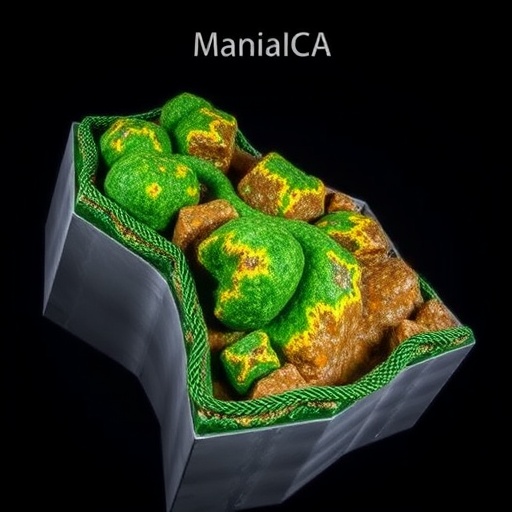In a groundbreaking study released in the journal Commun Earth Environ, researchers have unveiled compelling biomarker evidence for the existence of a serpentinite chemosynthetic biosphere in the Mariana forearc. This discovery not only sheds light on the possibility of life in extreme environments, such as those found in the deep-sea, but also deepens our understanding of the biochemical processes that fuel life in such seemingly inhospitable settings.
The Mariana forearc, located at the world’s deepest oceanic trench, is a geological marvel where tectonic plates converge and create extreme conditions of high pressure, darkness, and temperature. Traditional perspectives on life have primarily focused on the sunlit photic zones of the oceans; however, discoveries like those reported by Kumawat and colleagues challenge our assumptions about the boundaries within which life can exist. The newly discovered serpentinite chemosynthetic biosphere is a testament to nature’s resilience and adaptability.
Serpentinite forms when water interacts with certain types of ultramafic rocks, a process that occurs prominently in subduction zones. This mineral is not only abundant but also central to a series of chemical reactions that can produce molecular hydrogen, which serves as an essential energy source for various extremophiles, organisms that thrive in extreme conditions. The biochemical pathways fueled by this hydrogen are what the researchers focused on when investigating the biosphere they report in their paper.
In the Mariana forearc, microbial life is not dependent on sunlight but rather harnesses energy through chemosynthesis—a process whereby organisms convert chemical substances into energy, much like plants convert sunlight into energy through photosynthesis. The research team utilized advanced analytical techniques to isolate and identify specific biomarkers that are indicative of microbial life that thrives on serpentinization products. The presence of these biomarkers strongly suggests that a robust community of chemosynthetic organisms exists in this extreme environment.
This study has implications beyond mere academic interest. Understanding chemosynthetic processes in extreme environments can help inform astrobiology and the search for extraterrestrial life, especially in environments that might mirror those found in our own oceanic depths. When looking for life on other celestial bodies, scientists now have a clearer picture of how life could potentially arise and sustain itself in environments that offer no sunlight.
As the research team delved deeper into the metabolic pathways of the identified microbes, they uncovered a vast diversity of archaeal and bacterial phyla that play significant roles in nutrient cycling. These organisms are likely integral to the overall ecosystem dynamics, contributing to the stability and longevity of the biosphere. This finding complicates our understanding of food webs in extreme environments, as it reveals complex interactions between different microbial communities and their mineral substrates.
The study highlights the importance of situating our understanding of biodiversity in the context of extreme environments. Historically, life was believed to flourish in more temperate and hospitable locations. However, the discovery of these extremophiles in the Mariana forearc suggests that life may have deeper roots than previously thought. The biomarker evidence points to ancient lineages of life that may have persisted for millennia, surviving and evolving through geological and environmental changes.
Researchers also incorporated insights from geochemistry to explain the prevalence of serpenitization in the Mariana forearc. The continual movement of tectonic plates means that fresh ultramafic rocks are being constantly introduced to reactive environments. This ongoing serpentinization process generates molecular hydrogen and other nutrients that sustain these specialized microbial communities. Thus, the interaction between geological processes and biological systems is more intertwined than has been traditionally understood.
Another fascinating aspect of this research is the potential applications of the findings in biotechnology. By studying these extremophiles, scientists may uncover new metabolic pathways and natural products that can lead to innovative applications in bioengineering, pharmaceuticals, and renewable energy. The enzymes produced by these microbes could provide an efficient means for biocatalysis, aiding in the development of sustainable practices and materials.
Furthermore, the implications extend into the realm of environmental science. Understanding the mechanisms that allow life to thrive in extremophilic environments offers insight into how ecosystems adapt to climate change and environmental stressors. The lessons learned from the microbial communities in the Mariana forearc could influence conservation efforts and strategies aimed at protecting deep-sea habitats that are under threat from human activities.
The discovery of the serpentinite chemosynthetic biosphere marks a significant milestone in oceanographic research. It opens new avenues for exploration in the deep-sea ecosystems and emphasizes the need for more exploratory missions to regions of the ocean that remain largely uncharted. As technology advances, more complex sampling techniques and analytical methods will likely uncover further biodiversity and novel biogeochemical processes in these extreme environments.
This research contributes significantly to the overall body of knowledge regarding extremophiles and their ecological roles. By exposing the intricacies of life within the Mariana forearc, Kumawat and colleagues have set the stage for future investigations that will expand on these findings and enhance our understanding of life’s resilience on Earth.
In summary, the revelations presented in the study of a serpentinite chemosynthetic biosphere at the Mariana forearc not only redefine our understanding of where and how life can exist but also stimulate curiosity about the vast complexity of life thriving out of sight. With the implications for astrobiology, biotechnology, and environmental science, this research is poised to inspire a future generation of scientists to explore life in Earth’s most extreme conditions and beyond.
Subject of Research: The existence of a serpentinite chemosynthetic biosphere at the Mariana forearc.
Article Title: Biomarker evidence of a serpentinite chemosynthetic biosphere at the Mariana forearc.
Article References: Kumawat, P., Albers, E., Bach, W. et al. Biomarker evidence of a serpentinite chemosynthetic biosphere at the Mariana forearc. Commun Earth Environ 6, 659 (2025). https://doi.org/10.1038/s43247-025-02667-6
Image Credits: AI Generated
DOI: 10.1038/s43247-025-02667-6
Keywords: chemosynthesis, extremophiles, Mariana forearc, serpentinite, microbial life




